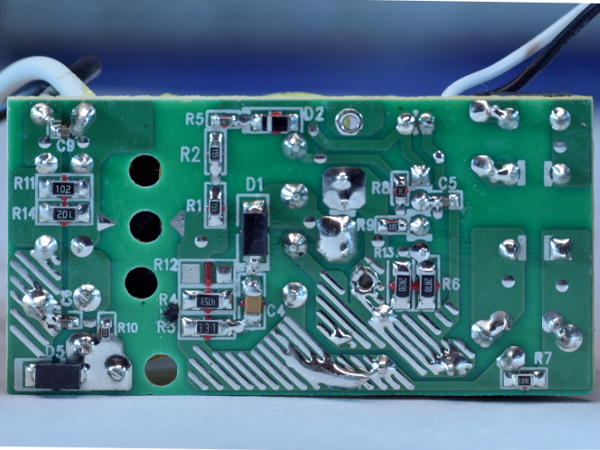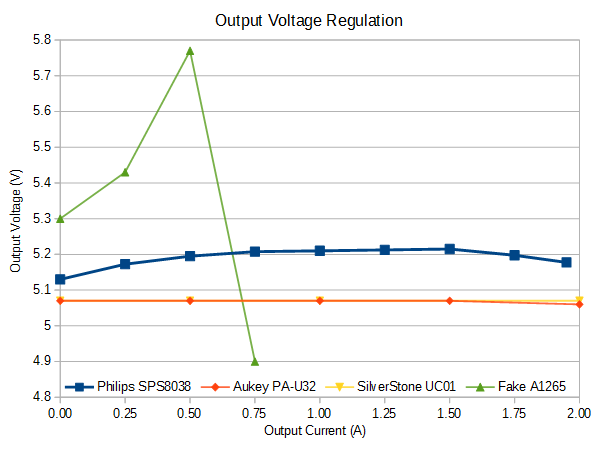Tom's Teardown: Philips SPS8038B AC USB Adapter
Main Board – Bottom
Most of the On-Bright chip’s support components reside on the bottom: the current-sense resistors near R6, the feedback and auxiliary supply network starting at D2, and the snubber network at D1.
On the output side, we see an extra diode to supplement the top side’s and an RC filter to provide some oscillation damping in the bottom-left corner. There's a proper spark gap near the middle, a pair of 1kΩ ballast resistors to prevent the primary-side sensing from grossly overshooting under no load, and a smal MLCC capacitor, too.
Just like SilverStone's UC01, Phillips also necks down its high-current traces at the output capacitors’ pins to provide maximum filtering.
MORE: Tom's Teardown: SilverStone UC01 USB Power Adapter
MORE: How (And Why) We Test USB Power Adapters
Spark Gap
In past stories, I commented on missing or half-done spark gaps and how they could easily be improved by simply changing hole locations on the board. Here, we have a ~5mm-wide gap with a slightly off-center hole in-between.
My only gripe is that there are a few spots between output ground and live-side traces that may be closer than the two spark gap points, such as the large copper islands across the bottom-most hole and the unnecessary copper excursion above the top-most hole on the full-board picture.
MORE: Tom's Teardown: SilverStone UC01 USB Power Adapter
MORE: How (And Why) We Test USB Power Adapters
Get Tom's Hardware's best news and in-depth reviews, straight to your inbox.
Funky Soldering
Philips didn’t hold back on glue for its SMD components to prevent the wave soldering process from washing them away. While through-hole component soldering looks perfectly fine, wave soldering surface-mount components sometimes does weird stuff, especially when larger components interfere with the solder wave.
In this picture, you can see solder nuggets on top of the diode and capacitor pads facing each other. Excess solder was about to either drip from those pads or merge with them, but solidified first.
MORE: Tom's Teardown: SilverStone UC01 USB Power Adapter
MORE: How (And Why) We Test USB Power Adapters
A Little Side-by-Side
If size is proportional to performance, then the SPS8038B with its much larger output capacitors and transformer should easily beat the PA-U32. Then again, the housing, packaging, and manual make no mention of efficiency standard compliance. Which way is it going to go? Let’s find out.
MORE: Tom's Teardown: SilverStone UC01 USB Power Adapter
MORE: How (And Why) We Test USB Power Adapters
Standby Power
Standby power is 93mW, cutting it a little close to the Level VI limit. The SPS8038B’s two input inductors do a fairly good job at slowing down inrush current rise when AC voltage catches up with the input capacitors’ voltage.
But there is something a little strange going on here: despite having a full-bridge input rectifier, which should make things symmetrical on the input, peak input current appears to be consistently higher by as much as 40mA or 30% on the negative polarity. The only explanation I can come up with is mismatched diodes within the input bridge. Nothing obvious shows up on my meter, though. They all read the same 596mV.
MORE: Tom's Teardown: SilverStone UC01 USB Power Adapter
MORE: How (And Why) We Test USB Power Adapters
Efficiency
I don't have anything particularly nice to say about efficiency: it dips below Level V efficiency at 500mA output, demonstrates a strange dip at about 1A due to the transition from discontinuous to continuous operation, then dips below Level IV efficiency. With 5W being dissipated under a 1.95A load, I expected to find an obvious hot spot. By touch, though, losses appear evenly spread across the board.
It's surprising to find an international brand exhibiting worse efficiency than the A1265 look-alikes I've been testing, particularly since it's using a design with a monolithic controller.
MORE: Tom's Teardown: SilverStone UC01 USB Power Adapter
MORE: How (And Why) We Test USB Power Adapters
Output Voltage Regulation
While the PA-U32 and UC01 overlap each other at a nearly constant 5.06V, the SPS8038B’s cable loss compensation makes it peak at 5.21V under a 1.5A load, which is a perfectly acceptable result. The Colorful A1265, on the other hand, fares rather poorly with output voltage peaking uncomfortably close to USB’s absolute maximum spec of 6V for 5V devices.
If you are confused about the 5.25V (+5%) maximum and 6V absolute maximum, the former is a normal operation limit, while the latter is what should be tolerable on a momentary basis, such as power supply overshoots during load transients.
MORE: Tom's Teardown: SilverStone UC01 USB Power Adapter
MORE: How (And Why) We Test USB Power Adapters
Output Noise Waveform
Below 1.25A, most of the noise is confined to the middle 100mV. The extra noise bursts appear at 1.25A and grow to over 200mVPP by 1.5A, where they remain steady for the remainder of the load tests. These bursts coincide with AC peaks every 8.33ms, which may indicate some sort of issue with the capacitors.
Capacitors that haven’t been charged in a long time will deteriorate to some extent, and can often be reconditioned by applying their rated voltage for several minutes to hours. Would letting the SPS8038B burn-in for a while make any difference?
MORE: Tom's Teardown: SilverStone UC01 USB Power Adapter
MORE: How (And Why) We Test USB Power Adapters
Output Noise – Post-Burn-In
After completing my initial tests, writing half of this story, re-measuring results that looked wrong to confirm them, and forgetting the adapter under a 1.25A load overnight as I went to bed trying to make sense of the weirdness, I came back the next day to find the AC-DC converter cured of its bursty noise issue. Now I have to re-do my other measurements to see how much the burn-in changed them.
MORE: Tom's Teardown: SilverStone UC01 USB Power Adapter
MORE: How (And Why) We Test USB Power Adapters
Peak-to-Peak Output Noise
Before burn-in, the SPS8038B’s noise was quite good until 1.25A, after which it shot up to twice the value. After burn-in, its light load noise increased by 70mVPP until 1.25A, where it settled around 150mVPP.
Leaving the SPS8038B on appears to have improved its capacitors’ ESR enough to better cope with the extra switching noise that comes with the converter going from discontinuous to continuous conduction at around 1A.
MORE: Tom's Teardown: SilverStone UC01 USB Power Adapter
MORE: How (And Why) We Test USB Power Adapters
-
cyaros I have one of these and it is convenient, but it whines. You can hear a high-pitched buzzing noise reminiscent of 50 cent phone chargers from Hong Kong when you plug it in, but otherwise I'm given no reason to believe it's dangerous.Reply -
Daniel Sauvageau Reply
If mine whined, it got buried under my test equipment's fans and I didn't notice it at all. Safety-wise, I gave this one to one of my sisters to replace the dollar-store adapters she uses in the kitchen until I find an even better one that can be reassembled after tear-down.20865348 said:I have one of these and it is convenient, but it whines. You can hear a high-pitched buzzing noise reminiscent of 50 cent phone chargers from Hong Kong when you plug it in, but otherwise I'm given no reason to believe it's dangerous.
-
wwenze "It's surprising to find an international brand exhibiting worse"Reply
It's not surprising when that brand is called Philips -
froozeball I find more reassurance in Daniel's teardowns and expose than in the government's ability(ies) to protect us from cheap cheap, and potential dangerous, USB chargers.Reply
Canada's Health Agency recently posted a recall on some of the more dangerous devices being sold at various Dollar store, Bargain Dollar, etc, type retailers in the country.
http://healthycanadians.gc.ca/recall-alert-rappel-avis/hc-sc/2018/66316a-eng.php
I'd sooner trust a name brand of some sort versus a no name, or WTF name brand in a dollar store or gas station.
Best trust of all - trust Toms and Daniel to keep us informed.
Merci a Daniel! -
Daniel Sauvageau Reply
There's an awful lot of A1265-like adapters on that Health Canada page, nearly half of 'em based on their low resolution images.20870511 said:Canada's Health Agency recently posted a recall on some of the more dangerous devices being sold at various Dollar store, Bargain Dollar, etc, type retailers in the country.
Best trust of all - trust Toms and Daniel to keep us informed.
Based on the three such units I've opened here so far, the recommendation is to stay as far away as possible from the A1265 form factor unless you are 100% certain it is a genuine Apple adapter. None of the generics (at least so far) are anywhere near safe. While digging through my adapter pile to decide which one to do next, I found another one of these I haven't opened yet. I might do another A1265 double-feature once I get my sister's dollar-store adapter. So far, every A1265 look-alike had a different layout from the others. I wonder how many of them there may be.
Bienvenu :)20870511 said:Merci a Daniel! -
Daniel Sauvageau Reply
It is for switching the charging spec resistors/voltages on D+ and D-.20875949 said:What do the A/B switches do on the USB ports?
One position uses voltage dividers, the other simply shorts the two pins together via a zero-ohm resistor.









